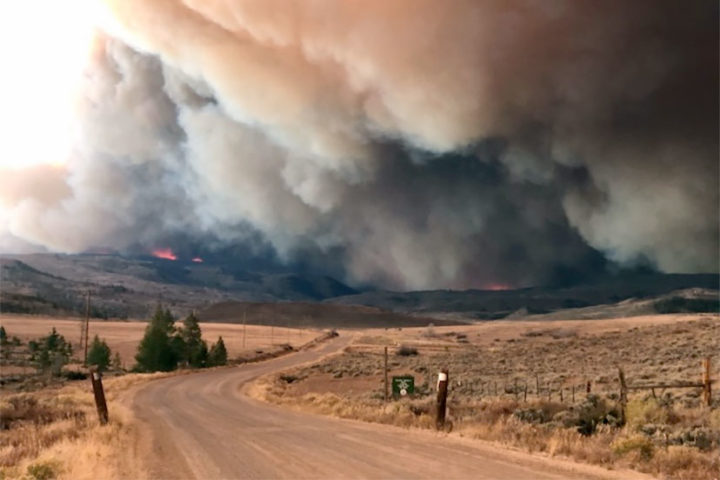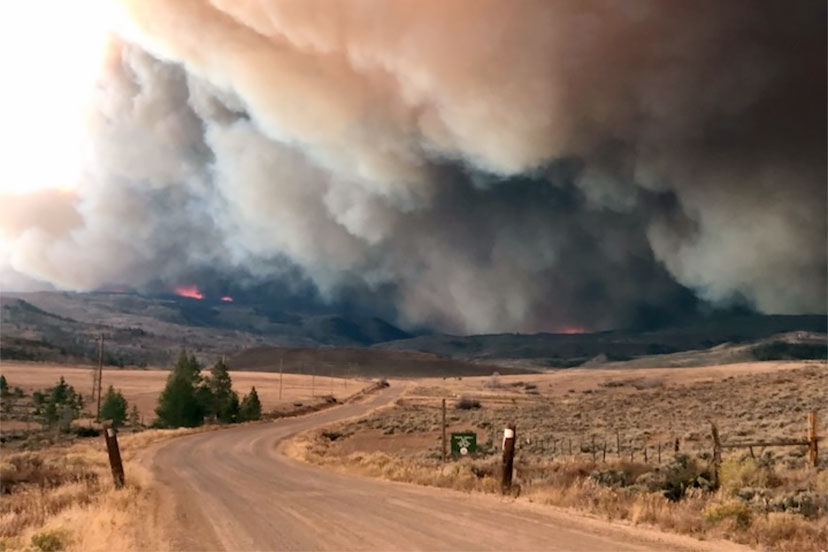This article first appeared on BigPivots.com on July 9, 2021.
Colorado’s scariest wildfire in 2020 was not its largest. East Troublesome shocked because of its sprint and then its leap. It grew by 87,000 acres in a fiery dash across the headwaters of the Colorado River and past Grand Lake, most of that in just a couple hours. Smoke plumes rose 40,000 feet. The winds, variously estimated at 50 mph to 100 mph, were strong enough to bend over lodgepole pines.
Then embers vaulted across two miles of treeless tundra at the Continental Divide, raining into the Estes Valley at the eastern gate to Rocky Mountain National Park.
Nothing like this had ever occurred in modern Colorado history.
Eight months later, Colorado again had something extraordinary, a record-smashing heat wave in mid-June. Two Colorado towns, Alamosa and Cortez, had six consecutive days of record high temperatures. Leadville, Grand Lake, Dillon and Del Norte had five straight days of record highs. In Vail, one town employee reported having gone to South Carolina to see a son — and being shocked to find the heat was no worse than that of Eagle County.
It’s not just new temperature records, but the jumps. Grand Junction, for example, shattered an old record by 4 degrees.
In the Pacific Northwest and British Columbia, the margins were even greater. Portland’s all-time high of 107 degrees was obliterated, with a new record of 112 degrees.
More shocking was the heat in British Columbia. “If you were drawing up a list of possible locations for hell on Earth before this week, the small mountain village of Lytton in Canada would probably not have entered your mind,” said the Guardian on July 3. The community of 250 people in the foothills of two mountain ranges registered a high of 121 degrees, surpassing anything ever recorded in Las Vegas and tying the all-time record in Death Valley.
Both phenomena — the East Troublesome Fire and the heat domes of June and early July — are likely manifestations of the warming climate.
It’s going to get worse, warn climate scientists, much worse. Temperatures will rise. Wildfires will become larger, more unpredictable. Welcome to the age of megafires.
In the footsteps of California
California has been getting megafires and, inevitably, so will Colorado, says Mark Novak, the Vail fire chief. When that happens — most likely in the next 10 to 15 years, he believes — Colorado will look back on East Troublesome and other fires during the shocking 2020 fire season as, well, not so shocking.
“I can’t tell you exactly at what point,” says Novak, “but we will look back and say, ‘Remember when Pine Gulch (a 2020 fire near Grand Junction) and East Troublesome seemed like a really big fire?’”
Before arriving in Vail in 2014, Novak saw a progression during his 30-year career on the West Coast.
“What we’re seeing today in Colorado is very similar to what California was seeing in the early years of the 2000s, from 2003 to 2007,” says Novak. “I believe that in 10 to 15 years we will see the same type of fire that California was seeing in 2017, 2018 and 2020. I think that (East Troublesome) was just the first case of what we will see in the future.”
In November, just weeks after the East Troublesome made its run, Novak told Vail Town Council members their community can someday expect something similar.
“I am here to tell you that fire burned extremely well and extremely fast through every fuel type,” he said. “It burned literally through aspen groves, it burned through beetle kill, it burned through green stands, it burned through sage (brush). It burned through farmers’ fields that were stubble. This was not necessarily a beetle-kill problem,” he said. “We should not rationalize that this kind of fire would not occur in Vail.”
“You scare me to death every time you speak,” a Town Council member responded.

Colorado, like California, has been seeing progressively larger fires, but on a different order of magnitude.
As Colorado’s ski areas came of age after World War II, fires were rare. There were fires, such as the one in 1994 west of Glenwood Springs that killed 14 firefighters amid the pinyon and juniper covered hillsides of Storm King Mountain. But in Vail, Aspen, and other headwater communities, wildfires were so distant that little attention was paid to flammability of buildings. In Vail, shake shingles were required. In Summit County, regulations discouraged removal of trees.
Fires in the 21st century have been larger, more frequent, and more destructive.
The year 2002 was a harbinger. A dry winter was followed by a warm and windy spring. In early June, three wildfires broke out almost instantaneously, one of them the Coal Seam Fire in Glenwood Springs. Surveying the state’s forests by planes that first Sunday, Colorado’s governor, Bill Owens, solemnly told reporters, “All of Colorado is on fire.”
The governor was widely ridiculed, but since then most of the state has been on fire. Most damaging were blazes in the foothills along the Front Range urban corridor. The Fourmile Canyon Fire west of Boulder destroyed 172 homes and other structures in 2010, the most destructive wildfire to that time. Then came 2012, hot and dry. High Park Fire killed one person and destroyed 248 homes west of Fort Collins. Days later, the Waldo Canyon Fire killed two people and destroyed 346 homes on the outskirts of Colorado Springs.
Flames have begun to singe Aspen, Vail, and other ski towns. In 2018, the Lake Christine Fire in the El Jebel-Basalt area incinerated 12,588 acres and nearly shut down electrical deliveries to Aspen during the Fourth of July weekend. Another fire, Grizzly Creek, shut down Interstate 70 in Glenwood Canyon for almost six weeks in 2020.
Fires covered fewer than 100,00 acres during the decade of the 1970s. Just last year, 650,000 acres burned in Colorado (and another 176,000-acre fire burned in a border-straddling fire that was mostly in Wyoming).
California covers a third more ground than Colorado. But the area burned last year, 4.4 million acres, was six times that of Colorado.
Vail’s Novak began his career fighting fires in the San Diego area in 1984. At the time, fires of 5,000 acres to 10,000 acres were considered large.
In 1990, he relocated to the Lake Tahoe Basin, on the California-Nevada border. The year 2007 was a pivotal one. One of the houses he had grown up in Southern California burned. At Tahoe, a major fire called Angora burned 250 houses within four hours. One of his children’s teachers lost her home, as did firefighters and police officers. Wildfire, more than before, had become personal to Novak.
Angora provoked a shift in attitudes in the Tahoe Basin. Forest thinning, which had been adamantly opposed, became more accepted. That fire now doesn’t make California’s top lists based on size, destruction, or deaths. The largest to date was 2020’s August Complex Fire, which covered more than a million acres, followed by the Mendocino Complex Fire of July 2018 that burned 459,000 acres. Deadliest was later that year. The Camp inferno killed 88 people at Paradise. Many others have killed 10, 15 or 25 at a time.
Hot and dry, off the charts
Fire in Colorado’s Rockies, as in California’s Sierra Nevada, has always been a part of forest ecosystems.
The frequency varies depending upon vegetation. In the foothills above the Front Range urban corridor, forests of Ponderosa pine and Douglas fir evolved with low-intensity, fast-moving fires that occurred every few decades.
On the Western Slope, in places like Aspen and Vail, the fires have historically occurred every 120 to 250 years. Frequency increases in the lower-elevation pinyon and juniper forests. Intervals in the higher-elevation spruce and fir forests lengthen to 400 years or more.
Fires are natural. Even big fires are natural, as charcoal collected from the mud of lakes and the scars of trees demonstrate. What we see now is not natural.
It begins with rising temperatures. The Colorado River Basin — including Aspen and Vail and the location of the East Troublesome Fire — have warmed 2 degrees Fahrenheit since 2000 as compared to the 20th century average. This, according to a report by Western Water Assessment, is likely warmer than at any time in the past 2,000 years.
Allen Best publishes the e-journal Big Pivots, which chronicles the energy transition in Colorado and beyond.

